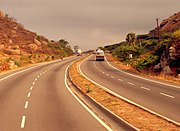Monday, December 22, 2008
National Highways - India
Sunday, December 21, 2008
Indian Highways
- Indian Highways constitute approx 2% of total road networks of India, but carry approx 40% of the total traffic.
- The longest National Highway is the NH7, which runs between Varanasi in Uttar Pradesh to Kanyakumari in Tamil Nadu, at the southernmost point of the Indian mainland, covering a distance of 2369 km, and passing through various metros like Jabalpur, Nagpur, Hyderabad and Bangalore.
- India has the distinction of having the world's second highest-altitude motor highway, Leh-Manali Highway, connecting Shimla to Leh in Ladakh, Kashmir.
- Very few of India's highways are concrete, the most notable being the Mumbai-Pune Expressway.
- Ahmedabad-Vadodara Expressway - This was India's first expressway. Length of 92.85 km.
- Delhi-Gurgaon Expressway - This expressway opened completely for the public on Jan 23, 2008, and is part of Golden Quadrilateral highway project.
- Mumbai-Pune Expressway - The Mumbai-Pune Expressway is India's first 6-lane, concrete, high-speed, tolled, access-controlled expressway.
- Taj Expressway also known as, Noida-Greater Noida Expressway.
- Delhi-Noida Direct Flyway is a eight-lane access controlled tolled expressway which connects Delhi to Noida, an industrial sub-urb area. It was built and is maintained by the Noida Toll Bridge Company Limited (NTBCL). NTBCL was developed under a Build-Own-Operate-Transfer (BOOP) model.
Wednesday, December 17, 2008
Demography (India) - Statistics
Population:
1,095,351,995 (July 2006 est.)
1,028,737,436 (2001 Census)
Rural Population:
742,617,747 (72.2%) (2001 Census)
Urban: Age structure:
0–14 years: 30.8%
15–64 years: 64.3%
65 years and over: 4.9% (2006 est.)
The average age of Indians is 26 years.
Population growth rate:
1.38% (2006 est.)
Birth rate: 22.01 births/1,000 population (2006 est.)
Death rate: 8.18 deaths/1,000 population (2006 est.)
Literacy rate:
64.8%
Percent of the population under the poverty line:
10%
Unemployment Rate:
9.2%
Sex ratio:
At birth: 1.05 male(s)/female
Under 15 years: 1.06 male(s)/female
15–64 years: 1.07 male(s)/female
65 years and over: 1.02 male(s)/female
Total population: 1.06 male(s)/female (2006 est.)
Life expectancy at birth:
total population: 64.71 years
male: 63.9 years
female: 65.57 years (2006 est.)
Total fertility rate: 2.73 children born/woman (2006 est.)
Religions:
Hindu 80.46%,
Muslim 13.43%,
Christian 2.34%,
Sikh 1.87%,
Buddhists 0.77%,
Jains 0.41 %,
Others or not stated 0.72% (2001 Census)
Scheduled Castes and Tribes:
Scheduled Castes: 16.2% (2001 Census)
Scheduled Tribes: 8.2% (2001 Census)
Languages:
There are 216 languages/dialects with more than 10,000 native speakers in India.
The largest of these by far is Hindi with some 337 million (the second largest being Bengali with some 70 million).
22 languages are recognized as "official languages".
Monday, December 15, 2008
16th December, 2008
- Birdflu outbreak in West Bengal
- Approval for National Investigation Agency (NIA)
- Estonia

















